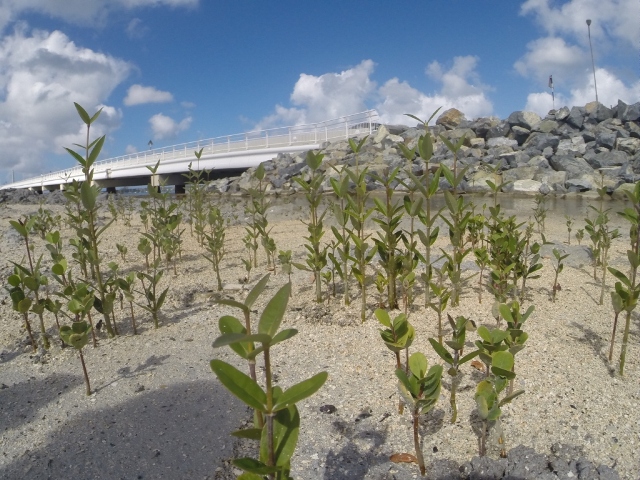
The Mangrove Management of the area surrounding the Simpson Bay Causeway has resulted in approximately 7850 new mangroves in the Simpson Bay Lagoon. During the initial phase of the construction of the Simpson Bay Causeway the Nature Foundation, SLAC, Ministry VROMI and Volkers Stevin held wide-scale consultations on how to best mitigate the effects the removal of mangroves will have on the ecosystem of the Simpson Bay Lagoon.
In the initial stage of the project juvenile mangroves were removed and were replanted at various locations around the island. Follow-up stages included reforestation techniques, monitoring, replanting initiatives and ecosystem management of the area. Based on all of these initiatives a total of 7850 new mangroves covering an area of 600 square meters was recorded during follow-up monitoring on the 13th of January. This is considered a successful reforestation project and one of the most successful mangrove reforestation initiatives on St. Maarten to date.
Mangrove forests are under severe pressure and disappearing at an alarming rate and it is estimated that about 60% of the total mangrove areas have disappeared. All four species of mangroves were recorded at the Causeway namely Rhizophora mangle (Red mangrove), Avicennia germinans (Black mangrove), Laguncularia racemosa (White Mangrove) and Conocarpus erectus (Buttonwood).
Invertebrates were also recorded including Queen Conch (Strombus gigas), Cushion Stars (Oreaster reticulata), Sea Cucumber (Holothuria mexicana), and the Upside Down Jellyfish (Cassiopeia frondosa).
Mangroves also act as a filter for water being washed off the land by preventing harmful sediments from smothering the coral reefs, including those of the Man of War Shoal Marine Protected Area. By establishing themselves successfully, the mangrove trees have the potential to become a thriving habitat for many other plants and animals as well as an important nursery for many species of fish. Fish using the mangroves as a nursery include Schoolmasters (Lutjanus apodus), Gray Snapper (Lutjanus griseus), Great Barracuda (Sphyraena barracuda) and the Foureye butterfly (Chaetodon capistratus).
Additional Mangroves will be planted on the western edge of the Causeway landing with the support of all stakeholders and constant follow-up will be done to ensure the survivability of the reforestation project.

